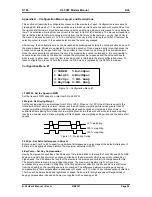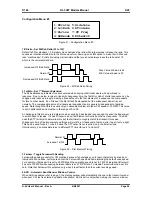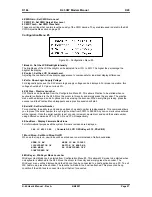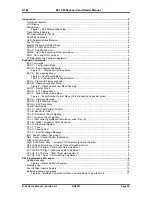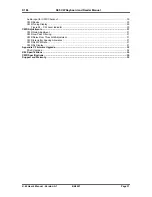
K1EL K45 CW Modem Manual K45
K-45 User’s Manual - Rev A
6/6/2021
Page 22
Appendix A – Configuration Menu Layouts and Descriptions
This section will describe the configuration menus and the members of each. Configuration is accessed by
pressing ESC followed by C. The various options are divided up into five menus each with eight entries. Use
the right and left arrows to move between menu columns and the up and down arrow keys to move between
rows. The selection will wrap from one column to the next in right or left directions. The menus will wrap from
first to last and last to first which helps in moving from the first menu to the last menu quickly. Each entry in
the menu is indexed by number 1 to 8. You can select this entry just by entering the number. Otherwise, the
selection cursor is moved to the desired selection and the enter key pressed.
Alternatively, the Configuration menu can be reached by pressing and holding the encoder button down until
the menu appears. Entries are navigated by turning the encoder. Once a desired entry is reached press the
encoder once quickly to open that entry. The encoder is then turned to scroll though the allowable values.
Once the value selection is complete, it is saved by pressing the encoder button again. It is not possible to
cancel a selection made by the encoder. Instead the entry must be re-opened and the value set back to
what is was. In either case, once the item is saved, control is returned to the main configuration menu. To
leave configuration, press and hold the encoder until the menu is replaced by the K45 main window.
Configuration Menu #1
1:TxWPM 5:AutoSpac
2:Weight 6:WordSpac
3:LtrSpc 7:Pdl Samp
4:KeyComp 8:Pdl Hang
Figure 16 – Configuration Menu #1
1:TXWPM - Set the Speed in WPM
Set the transmit WPM speed to a rate from 05 to 99 WPM.
2:Weight - Set Keying Weight
Set the keying weight in a percentage from 50% to 150%. When set to 100 % the dit time is equal to the
inter-element time, which is normal. Values less than 50 reduce weighting while values greater than 50
increase weighting. Weighting does not affect sending speed because any increase in keyed time is
subtracted from spacing time. Reduction in weighting results in a thinner sound while increased weighting
results in a heavier sound. Since weighting will track speed, one weighting setting will sound the same at all
speeds.
50 % weighting
100 % weighting
150 % weighting
Figure 17 – Weighting Timing
3:LtrSpc - Set Extra Letterspace in Percent
Enter a value from 0 to 62, to specify an additional letterspace as a percentage of the default letterspace (3
dit times) to be applied between letters. The maximum adjustment is 62%.
4:KeyComp - Set Key Compensation
Keying Compensation specifies a fixed amount of time to be added to the length of both dits and dahs. QSK
keying on modern transceivers can cause shortening of these elements which is especially noticeable at
high speeds. The K45 allows the length of the elements to be increased uniformly to compensate for this.
The adjustments are made in one-millisecond steps. The maximum adjustment is 31 mSecs. Key
compensation is very similar to Weighting in that any adjustment added to the dits and dahs is subtracted
from the spacing, so the resulting speed is not changed. The difference between weighting and keying
compensation is that compensation is independent of speed, so if 10 mSec of key compensation is selected,
10 mSec will be always be added regardless of speed. So be careful at high speeds with large values of
keying compensation, dits and dahs may run together with no spacing at all.















